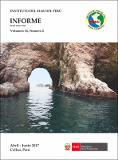Por favor, use este identificador para citar o enlazar este ítem:
https://hdl.handle.net/20.500.12958/3211Registro completo de metadatos
| Campo DC | Valor | Lengua/Idioma |
|---|---|---|
| dc.contributor.author | Velazco Castillo, Federico | - |
| dc.contributor.author | Solís Acosta, Juana | - |
| dc.contributor.author | Calderón, Iván | - |
| dc.contributor.editor | Instituto del Mar del Perú | - |
| dc.date.accessioned | 2018-08-14T20:37:46Z | - |
| dc.date.available | 2018-08-14T20:37:46Z | - |
| dc.date.issued | 2017 | - |
| dc.identifier.citation | Inf Inst Mar Perú 44(2), 2017, p. 259-267 | es_ES |
| dc.identifier.issn | 03787702 | - |
| dc.identifier.uri | https://hdl.handle.net/20.500.12958/3211 | - |
| dc.description.abstract | Por el sector oeste del Área Natural Protegida (ANP) Isla Lobos de Tierra, se presentan relieves que se enlazan con la plataforma continental externa a través de superficies de elevada pendiente y son cortados por debajo de los 50 m por canales en dirección este-oeste; en el lado este de la isla (sector abrigado) las pendientes del fondo marino son más suaves con presencia de niveles sub-horizontales que favorecen la sedimentación. Los sedimentos superficiales del fondo marino del ANP son predominantemente arenosos, compuestos por fragmentos de conchas de moluscos que generan hasta 87% de carbonatos totales; la otra fracción son partículas minerales de variado tamaño. En el extremo noroeste del ANP, los sedimentos tienen hasta 8% de materia orgánica total y están asociados a sedimentos con textura de fango (mayor contenido de limo). En el sustrato predominantemente formado por partículas calcáreas son abundantes las praderas de Caulerpa y de poliquetos cuyos tubos tapizan el fondo marino. En el sector submarino rocoso y somero alrededor de la isla se encontró principalmente rocas metamórficas tales como esquistos y gneises, los que en conjunto con el sector emergido de la isla, son la fuente de aporte de partículas minerales que se incorporan a los depósitos marinos a través de procesos de intemperismo subaéreos, alteración química y erosión marina y por los procesos de transporte en los cuales gravedad, viento, olas y corrientes son los principales agentes. | es_ES |
| dc.description.abstract | ABSTRACT: The surface sediments of the bottom of the Natural Protected Area (NPA) Lobos de Tierra are predominantly sandy, formed by fragments of mollusk shells that generate up to 87% of total carbonate; the other fraction is composed of mineral particles of varied sizes. In the Northwest corner of the NPA, the sediments have up to 8% of total organic matter and are associated with sediment of mud texture (higher silt content). These sediments by the West sector of the NPA are reliefs which are linked with the outer continental shelf through high slope surfaces and are cut below 50 m through channels in east-west direction; while on the East side of the island (sheltered sector) slopes of the seabed are softer with sub-horizontal levels that favor the sedimentation over erosive processes; prairies of Caulerpa and polychaetes whose tubes cover the seabed are abundant in this area on the substrate predominantly composed of calcareous particles. The underwater shallow and rocky sector around the Lobos de Tierra island is primarily made up of metamorphic rocks such as schist and gneiss, which, in conjunction with the sector emerged from the island, are the source of supply of mineral particles which are incorporated into the marine deposits through subaerial weathering processes, chemical alteration and marine erosion and transport processes in which gravity wind, waves and currents are the main agents. | - |
| dc.language.iso | spa | es_ES |
| dc.publisher | Instituto del Mar del Perú | es_ES |
| dc.relation.ispartofseries | Informe IMARPE;44(2), 2017 | - |
| dc.rights | info:eu-repo/semantics/openAccess | es_ES |
| dc.rights.uri | https://creativecommons.org/licenses/by/4.0/ | es_ES |
| dc.source | Instituto del Mar del Perú - IMARPE | es_ES |
| dc.source.uri | Repositorio Digital IMARPE | es_ES |
| dc.subject | Sedimentos marinos | es_ES |
| dc.subject | Morfología | es_ES |
| dc.subject | Fondo marino | es_ES |
| dc.subject | Roca metamórfica | es_ES |
| dc.title | Morfología y sedimentos superficiales del fondo marino de la isla Lobos de Tierra, Lambayeque, Perú. Abril 2015 | es_ES |
| dc.title.alternative | Morphology and surface sediments from the bottom of the Lobos de Tierra Island, Lambayeque, Peru. April 2015 | es_ES |
| dc.type | info:eu-repo/semantics/article | es_ES |
| Aparece en las colecciones: | Informe Vol. 44(2) 2017 | |
Ficheros en este ítem:
| Fichero | Descripción | Tamaño | Formato | |
|---|---|---|---|---|
| Informe 44(2)6.pdf | 5,86 MB | Adobe PDF |  Visualizar/Abrir |
Este ítem está sujeto a una licencia Creative Commons Licencia Creative Commons

